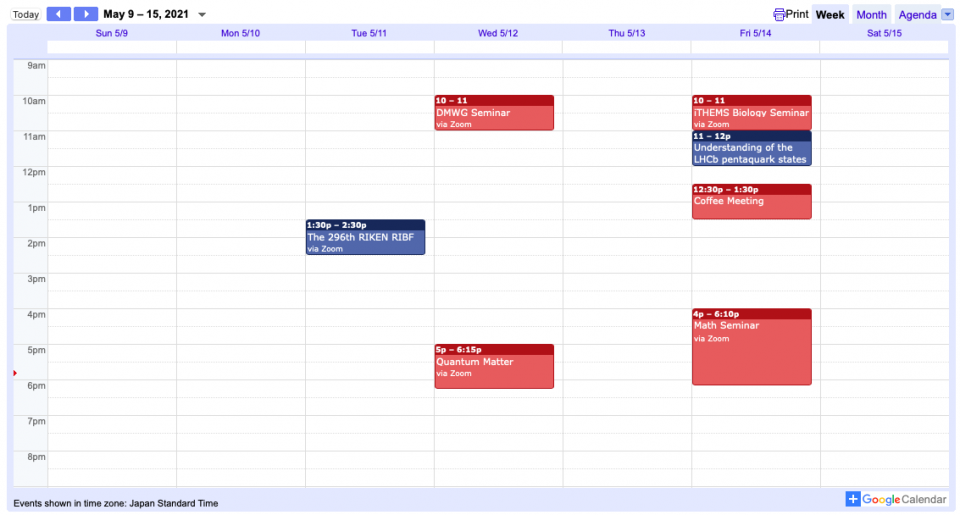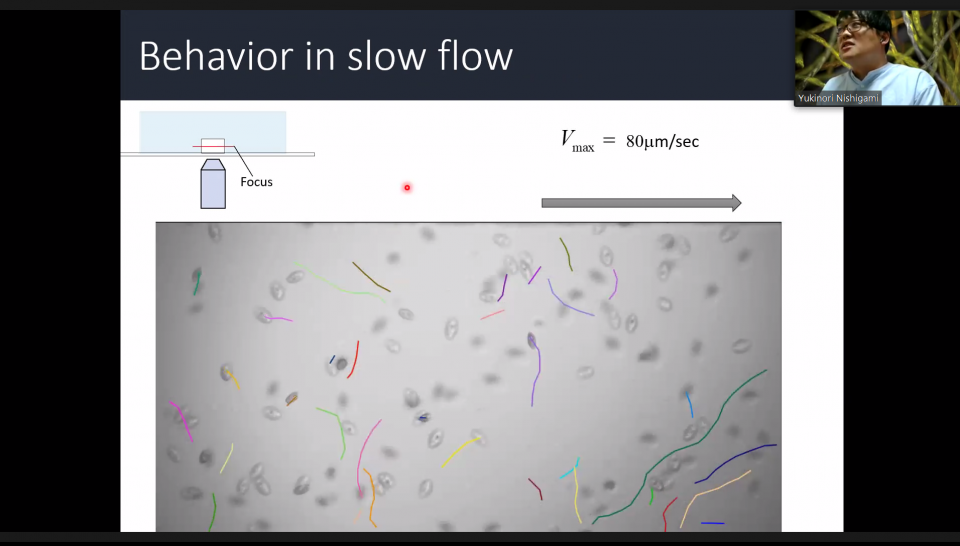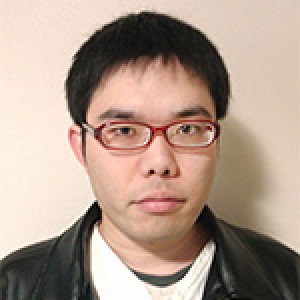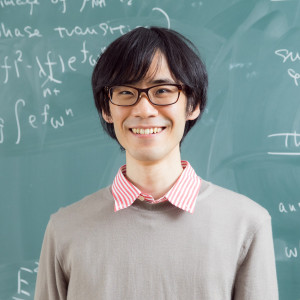Volume 149
Back to Newsletter List
Event Schedule
Events for the 3rd week of May 2021
2021-05-06
Wednesday, May 12, 10:00- DMWG Seminar
Wednesday, May 12, 17:00- Quantum Matter Seminar
Friday, May 14, 10:00- iTHEMS Biology Seminar
Friday, May 14, 12:30- Coffee Meeting
Friday, May 14, 16:00- Math Seminar
Seminar Report
iTHEMS Biology Seminar by Dr. Yukinori Nishigami on April 22, 2021
2021-05-06
In iTHEMS biology seminar on April 22, Dr. Yukinori Nishigami (Hokkaido Univ.) gave us a talk about his research results, such as modeling the swimming behavior of unicellular organisms in their environment. First, Dr. Nishigami introduced us to the diversity of unicellular eukaryotes and the fact that they have their own specific movements. Many of the participants were amazed at how a small, single-celled organism can move in complex ways using flagella and other mechanisms, and how the cells themselves can move in complex ways.
Next, he talked about the main topic: modeling the phenomenon of ciliate accumulation in a stable environment. Through careful observation and simulation, he modeled the movement and found that the movement of ciliates in such an environment is due to the simple principle of cell shape and mechanosensitivity of cilia. He presented a good example of modeling the behavior of unicellular organisms, which led to a lively discussion at the seminar. Thank you very much, Nishigami-san!
Reported by Euki Yazaki
The rheotaxis mechanism of swimming ciliates
April 22 (Thu) 10:00 - 11:00, 2021
Upcoming Events
Seminar
DMWG Seminar
Emulation for lensing and clustering observables of the cosmological large-scale structure
May 12 (Wed) 10:00 - 11:00, 2021
Takahiro Nishimichi (Yukawa Institute for Theoretical Physics, Kyoto University)
Recent developments in observational technologies open exciting opportunities to map out the detailed structure of the universe. Remarkably, the unique combination of imaging and spectroscopic galaxy surveys is now becoming well established as a standard analysis methodology for precision cosmology. While the former can access directly the underlying clustering of mass dominated by dark matter projected on the sky through the weak gravitational lensing effect, the latter provides us with the three dimensional map of the structure traced by galaxies. One can mitigate the galaxy-bias uncertainty, which has been the major obstacle for cosmology based on galaxy surveys, by jointly analyzing these effects. We still need, however, a robust and versatile theoretical and statistical framework to interpret these datasets. The Dark Quest project, launched in 2015, is a structure formation simulation campaign precisely
for this purpose. We have developed an emulation tool, dubbed as Dark Emulator, based on a large database of simulated dark matter halos in virtual universes with different cosmologies efficiently sampled in six-dimensional parameter space. Dark Emulator employs a simple machine-learning architecture with Gaussian process at its core. It makes predictions of various statistical measures of dark matter halos, both lensing and clustering observables, for a given cosmological parameters in a few seconds on laptop computers without running a new simulation. This AI-aided tool, once supplemented with recipes for the halo-galaxy connection, is therefore applicable to real-data analyses as the theoretical template, which typically requires hundreds of thousands of function calls in the course of parameter inference. I will introduce this project and report the status of its application to Subaru HSC data.
We are looking forward to seeing you online.
Venue: via Zoom
Event Official Language: English
Seminar
Quantum Matter Seminar
Aperiodic and amorphous topological phases
May 12 (Wed) 17:00 - 18:15, 2021
Christopher Bourne (Visiting Scientist, RIKEN Interdisciplinary Theoretical and Mathematical Sciences Program (iTHEMS) / Assistant Professor, Advanced Institute for Materials Research (AIMR), Tohoku University)
Key features of topological insulators and superconductors such as stable edge modes have been found in an increasingly broad class of materials and systems. In this talk, I will introduce a mathematical framework to study Hamiltonians and topological phases on a general class of (aperiodic/random) point atterns. Using techniques from noncommutative geometry, we then show how bulk topological invariants and the bulk-boundary correspondence can be rigorously established in such generic systems.
This is based on joint work with Emil Prodan and Bram Mesland.
*Detailed information about the seminar refer to the email.
Venue: via Zoom
Event Official Language: English
Seminar
iTHEMS Biology Seminar
Modeling Membrane Morphological Change during Autophagosome Formation
May 14 (Fri) 10:00 - 11:00, 2021
Yuji Sakai (Visiting Scientist, RIKEN Interdisciplinary Theoretical and Mathematical Sciences Program (iTHEMS) / Assistant Professor, Graduate School of Medicine and Faculty of Medicine, The University of Tokyo)
Membrane-bound organelles compartmentalize eukaryotic cells and adopt various characteristic shapes such as disk-shaped, tubules, spherical vesicles, and their intermediate structures. Organellar morphology is regulated by protein and lipid compositions. Because organellar shape directly relates to organellar function, it is important to understand the mechanisms regulating organelle morphology. In autophagy, the morphologies of the isolation membrane change from disk- to cup-shaped, closed spherical double-membrane structure. Eventually the membrane engulfs the cytoplasmic materials. In this study [1], we investigate the dynamics of the continuous membrane morphological transition in autophagy, which is governed by the spatiotemporal regulation of curvature generators.
*Please refer to the email to get access to the Zoom meeting room.
Reference
Venue: via Zoom
Event Official Language: English
Seminar
iTHEMS Math Seminar
Geometry of canonical metrics on Kähler manifolds
May 14 (Fri) 16:00 - 18:10, 2021
Eiji Inoue (Special Postdoctoral Researcher, RIKEN Interdisciplinary Theoretical and Mathematical Sciences Program (iTHEMS))
The aim of this talk is to report recent trends in Kähler geometry. Kähler geometry consists of two aspects: the one is algebraic geometry and the other is metric geometry.The first one hour is an introduction for non-mathematicians.
I begin with a simple example of algebraic variety from ancient Greek, which I believe is the simplest example illustrating motivation for compact complex manifolds.
On the other hand, I explain the first motivation for canonical metrics in Kähler geometry via Riemann’s uniformization theorem.The last one hour is an introduction to recent trends in Kähler geometry, especially Kähler-Einstein metrics.
The existence of Kähler-Einstein metrics turns out to be related to geometry of degenerations of space, which is so called Yau-Tian-Donaldson conjecture.
I explain various aspects of this topic. We encounter deep studies in metric geometry, birational geometry and non-archimedean geometry.
I finally explain recent breakthrough on Kähler-Ricci flow.The goal of this talk is the starting point of my study. I briefly explain my study if time permits.
Venue: via Zoom
Event Official Language: English
Paper of the Week
Week 2 of May, 2021
2021-05-06
Title: Asymptotic behavior of fronts and pulses of the bidomain model
Author: Hiroshi Matano, Yoichiro Mori, Mitsunori Nara, Koya Sakakibara
arXiv: http://arxiv.org/abs/2105.00169v1
Title: Na+/Ca2+ exchanger mediates cold Ca2+ signaling conserved for temperature-compensated circadian rhythms
Author: Naohiro Kon, Hsin-tzu Wang, Yoshiaki S. Kato, Kyouhei Uemoto, Naohiro Kawamoto, Koji Kawasaki, Ryosuke Enoki, Gen Kurosawa, Tatsuto Nakane, Yasunori Sugiyama, Hideaki Tagashira, Motomu Endo, Hideo Iwasaki, Takahiro Iwamoto, Kazuhiko Kume, Yoshitaka Fukada
Journal Reference: Science Advances, Vol. 7, no. 18, eabe8132
doi: https://dx.doi.org/10.1126/sciadv.abe8132
If you would like to cancel your subscription or change your email address,
please let us know via our contact form.
Copyright © iTHEMS, RIKEN. All rights reserved.






